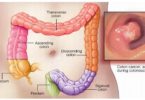What's in this article?
Liver cancer, also known as hepatic cancer, is a cancer which starts in the liver, rather than migrating to the liver from another organ or section of the body. In other words, it is a primary liver cancer.
Cancers that originate elsewhere and eventually reach the liver are known as liver metastasis or secondary liver cancers, and are most commonly from cancer of the gastrointestinal (GI) tract (colon cancer), lung cancer, renal cancer (cancer of the kidney), ovarian cancer and prostate cancer.
The liver, which is located below the right lung and under the ribcage is one of the largest organs of the human body. It is divided into the right and left lobes. Nutrient-rich blood is carried by the portal vein from the intestines to the liver, while oxygen-rich blood reaches the liver from the hepatic artery.
All vertebrates (animals with a spinal column) have a liver, as do some other animals. The liver has a range of functions, including detoxification (getting rid of toxins), synthesizing proteins, breaking down fats, and producing biochemicals that are essential for digestion. We cannot survive without a liver.
What Causes Liver Cancer?
Primary liver cancer (hepatocellular carcinoma) tends to occur in livers damaged by birth defects, alcohol abuse, or chronic infection with diseases such as hepatitis B and C, hemochromatosis (a hereditary disease associated with too much iron in the liver), and cirrhosis. More than half of all people diagnosed with primary liver cancer have cirrhosis a scarring condition of the liver commonly caused by alcohol abuse. Hepatitis B and C and hemochromatosis can cause permanent damage and liver failure. Liver cancer may also be linked to obesity and fatty liver disease.
Symptoms of Liver Cancer
Most people don’t have signs and symptoms in the early stages of primary liver cancer. When signs and symptoms do appear, they may include:
- Losing weight without trying
- Loss of appetite
- Upper abdominal pain
- Nausea and vomiting
- General weakness and fatigue
- Abdominal swelling
- Yellow discoloration of your skin and the whites of your eyes (jaundice)
- White, chalky stools
What are the risk factors for Liver Cancer?
Incidence rates of hepatocellular cancer are rising in the United States due to increasing prevalence of cirrhosis caused by chronic hepatitis C and steatohepatatis (non-alcoholic fatty liver disease).
Cirrhosis of the liver due to any cause is a risk factor for liver cancer. The risk factors for liver cancer in cirrhosis are being male, age 55 years or older, Asian or Hispanic ethnicity, family history in a first-degree relative, obesity, hepatitis B and C, alcohol use, and elevated iron content in the blood due to hemochromatosis.
Chronic hepatitis B infection even without cirrhosis is a risk factor for liver cancer.
Treatment for Liver Cancer
Treatment depends on how advanced the cancer is.
Surgery may be done if the tumor has not spread. Before surgery, the tumor may be treated with chemotherapy to reduce its size. This is done by delivering the medicine straight into the liver with a tube (catheter) or by giving it intravenously (by IV).
Radiation treatments in the area of the cancer may also be helpful. But in people who have liver cirrhosis or other liver diseases, radiation is difficult to perform.
Ablation is another method that may be used. Ablate means to destroy. Types of ablation include using:
- Radio waves or microwaves
- Ethanol (an alcohol) or acetic acid (vinegar)
- Extreme cold (cryoablation)
A liver transplant may be recommended for certain people who have both cancer and cirrhosis.
If the cancer can’t be surgically removed or has spread outside the liver, there is usually no chance for long-term cure. Treatment instead focuses on improving and extending one’s life. Treatment in this case is chemotherapy, and can be taken as pills or given through a vein (by IV).






Leave a Comment